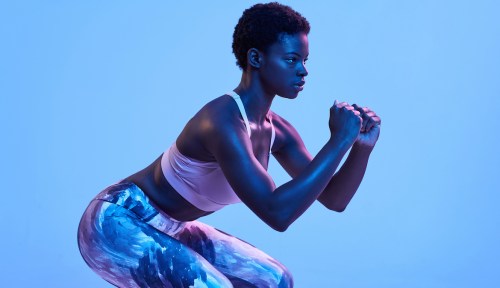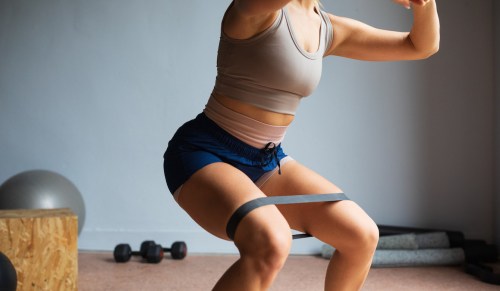Pull-ups are one of the most humbling bodyweight exercises out there. Many people (even fit ones!) have trouble completing a single rep. Case in point: An April 2020 study1 published in the Journal of Strength and Conditioning Research examined the pull-up performance of almost 1,000 law-enforcement-officer recruits in a standardized fitness assessment. Only 20 percent of the female recruits completed more than two pull-up reps.
Experts in This Article
personal trainer with the Centr app
a certified personal trainer and co-founder and president of fitness at VICTRESS MVMT, a fitness training facility in Lincoln, Nebraska
“A true bodyweight pull-up can be considered the holy grail of movement patterns for a lot of people,” says Stacy Orsborn, CPT, certified personal trainer and co-founder of Victress MVMT.
It can take time, sweat, and tears to master pull-ups, but it’s certainly not impossible—and the benefits you get in return are pretty powerful, from a stronger upper body and grip to an empowered can-do attitude. Keep reading for more on the key benefits of pull-ups, plus how to do them correctly and modify them for any level.
The benefits of pull-ups
1. Increased functional strength
“The biggest benefits of pull-ups include increased upper-body strength, improved grip strength, and enhanced muscular endurance,” says Ingrid Clay, CPT, a certified personal trainer on Chris Hemsworth’s fitness and wellness platform Centr.
We probably don’t need to sell you on the value of getting stronger, but they bear repeating. “These benefits translate well to everyday activities such as lifting heavy objects, climbing, or even carrying groceries,” Clay says. Pull-ups engage muscles from your lower back up to your fingertips, recruiting a ton of muscles and helping you build strength throughout your upper body.
2. Better posture
The functional strength developed through pull-ups can also help improve posture, Clay says. Pull-ups mainly work muscles in your back (including the latissimus dorsi, rhomboids, and trapezius) as well as stabilizer muscles in your core and shoulders, all of which help you maintain upright posture for long periods of time.
3. Boosted sports performance
The upper-body strength you build with pull-ups can help you power through other workouts (think: crushing a 2000m row, lifting heavier weights, doing HIIT on an air bike) or tackle your favorite activities with more ease.
“For sports—particularly anything involving pulling motions like rowing, swimming, or rock climbing—mastering pull-ups will give you a huge advantage in terms of power and endurance,” Orsborn says. Building up back and shoulder strength with pull-ups can also help you execute a strong overhead smash on the pickleball court and a more powerful paddle on a surfboard or kayak.
4. Improved grip strength
As Clay mentioned above, pull-ups can help improve grip strength—and that’s no small thing. A stronger grip can help you do everyday things like open peanut butter jars or better hold onto a heavy suitcase, but it also has bigger implications. A November 2022 study2 in the Journal of Cachexia, Sarcopenia and Muscle shows that increased grip strength is associated with a longer life span, while a weaker grip may be a predictor of negative future health outcomes like cardiovascular disease and cancer.
That said, it’s unclear whether improving grip alone will convey health benefits; researchers involved in an October 2019 review3 in Clinical Interventions in Aging believe the protective effect of grip strength may be due to its associations with more total-body strength, bone density, and reduced risk of falls, for example.
5. Healthier shoulders
Fun fact: The shoulder joint4 has the largest range of motion of any joint in the human body. Pull-ups take the shoulder through nearly this entire range and strengthen muscles all around it, improving the health of the joint5 by promoting stability in the shoulder girdle and activating the muscles that stabilize the scapulas (aka shoulder blades).
“Pull-ups help you develop the kind of back and shoulder strength that supports your posture and makes everyday movements easier, which is a big deal, especially as you age,” Orsborn says.
6. More balanced strength
Many people’s workout routines unintentionally emphasize “push” movements—exercises that focus on the pushing muscles on the front of the body, like planks, push-ups, and presses. This can lead you to develop an imbalance in strength between the front and back of the body.
An April 2013 study6 published in the International Journal of Sports Physical Therapy found that upper body “pushing” muscles were approximately 1.5 to 2.7 times stronger than the “pulling” muscles in healthy recreationally active adults. As their name suggests, pull-ups work the pulling muscles. Regularly including them in your routine can help balance out your upper-body strength or prevent imbalances from developing in the first place.
7. Better mental health
Research shows that strength training, in general, has a positive effect on mental health, including reducing symptoms of depression7 and anxiety8 and potentially increasing self-efficacy and self-worth9.
There’s a unique magic to working toward and mastering a challenging move like pull-ups. “Being able to complete a true full pull-up can be such a mentally and physically empowering experience,” Orsborn says. The sense of accomplishment you get when you complete your first pull-up or gain the ability to bang out a few reps in a row is pretty darn powerful.
How to do a pull-up perfectly every time
To do a pull-up properly, you’ll need a pull-up bar—ideally, one that’s high enough that you can hang with your legs and arms extended and not touch the ground. This means you’ll likely need to step up onto a bench or box to grab the bar. Be sure to choose something stable and recruit a spotter if necessary. Here’s how to do a pull-up with proper form, according to Clay and Orsborn.
- 1.Carefully step up to the pull-up bar and hold onto it with an overhand grip (your wrists facing away from you) and your hands slightly wider than shoulder-width apart. Start with your arms fully extended and your body hanging straight.
- 2.Engage your core and pull your shoulder blades down and together. Using your lats, pull your chest toward the bar.
- 3.As you reach the top of the pull-up, keep your elbows close to your sides and pointing down toward the floor.
- 4.Keep pulling until your chin is above the bar.
- 5.Hold for one second, keeping your shoulders down and away from your ears.
- 6.Slowly reverse the movement, lowering your body with control to return to the starting position.
Some pro tips: “Keep your core tight and control the movement to avoid using momentum to pull yourself up,” Orsborn says. That means no swinging or kipping. “A controlled movement is essential for maximum effectiveness and safety,” Clay adds. To properly engage your lats, it can be helpful to imagine you’re trying to bend the bar into an upside-down “U” shape.
“Like any exercise, progress comes from showing up regularly for yourself and your body.” —Stacy Orsborn, CPT
Pull-up muscles worked
“Pull-ups mainly target your back muscles, with the latissimus dorsi10 (aka “lats”) doing most of the heavy lifting,” Orsborn says. The lats are one of the biggest muscles in the body, and stretch from your armpit to your spine, running all the way from the middle to the lower part of your back—sort of like wings. In addition to your lats, your trapezius and rhomboids (two muscles in your upper back important for proper movement of the scapula) are also key for executing pull-ups.
Pull-ups also recruit muscles in your forearms and shoulders, as well as your biceps, Orsbon says. And believe it or not, your core is doing some important work while you’re hanging from the bar: “While your back takes the brunt of the work, your core and stabilizer muscles also play a role in keeping your body aligned throughout the movement—if you’re doing it properly,” Orsborn adds.
Beginner pull-up modifications
Pull-ups are challenging, but there are plenty of ways to modify the move so it meets you at your level. Practicing modifications like scapula squeezes can help improve the mind-body connection between your brain and the muscles needed to execute pull-ups, ensuring you’re using the right ones to get the job done.
Below, Clay shares her favorite modifications that’ll help you work up to doing pull-ups on your own. “By incorporating these exercises, you can gradually build the strength and confidence needed to perform pull-ups effectively,” she says.
1. Scapular squeeze
This move (also called a hanging scapular retraction) helps activate the back muscles and build the foundational strength needed for pull-ups, Clay says. And, as mentioned above, it’s great for cultivating a mind-muscle connection.
- 1.Carefully step up to the pull-up bar and hold onto it with an overhand grip (your wrists facing away from you) and your hands slightly wider than shoulder-width apart. Start with your arms fully extended and your body hanging straight.
- 2.Without bending your elbows, squeeze your shoulder blades down and together.
- 3.Hold for one second, then release. That’s one rep.
- 4.Repeat.
2. Negative pull-up
Negative pull-ups focus on the eccentric part of the exercise, i.e., the downward phase, when your muscles are lengthening. Because you start the movement at the top of a pull-up, you may need to jump up to the bar or step from a bench or box.
- 1.Carefully step up onto a support to grab a pull-up bar. Hold it with an overhand grip (your wrists facing away from you) with your hands slightly wider than shoulder-width apart.
- 2.Start with your chin above the bar, legs hanging, and elbows close to your sides, in the top position of a pull-up rep. (If your pull-up bar isn’t very high, you can also jump up to the starting position.) Think about pulling your shoulder blades back and down; don’t let your shoulders creep up toward your ears.
- 3.Slowly lower your body with control until your arms are fully extended. That’s one rep.
- 4.Repeat.
3. Assisted pull-up
One reason pull-ups are so hard is because you’re lifting your entire body weight. Offloading some of your weight onto a support allows you to focus on the pull-up movement without the full load, Clay says. You can do this by looping a resistance band around the pull-up bar or by placing a step or bench underneath and using your leg strength to help you complete the pull-up.
- 1.Loop a large resistance band around a pull-up bar, and pull one end through the other so it’s secure.
- 2.Hold the pull-up bar with an overhand grip (your wrists facing away from your), hands shoulder-width apart, and place one or both feet into the resistance band loop.
- 3.Extend your arms fully, and allow the resistance band to hold your weight.
- 4.Engage your core and pull your shoulder blades down and together. Using your lats, pull your chest toward the bar.
- 5.As you reach the top of the pull-up, keep your elbows close to your body and pointing down toward the floor.
- 6.Keep pulling until your chin is above the bar.
- 7.Hold for one second, keeping your shoulders down and away from your ears.
- 8.Slowly reverse the movement, lowering your body with control to return to the starting position. That’s one rep.
- 9.Repeat.
If you don’t have a resistance band, you can also perform assisted pull-ups by placing a step or box under the bar and keeping some weight in one or both of your legs, aiming to perform the move with your arms but helping with your lower body as needed.
How to add pull-ups to your workout routine
If you’d like to master pull-ups, start by incorporating modifications like the ones listed above into your routine regularly. Orsborn suggests doing three sets of five to eight reps of one of the above modifications, including them in your workouts two or three times per week.
Gradually increase the difficulty of the move (for example, decreasing the amount of assistance) or increasing reps as you build up strength. Once you can do a pull-up solo, you can follow a similar routine, increasing the intensity or adding variety by switching your grip, playing with time under tension, or adding additional weight.
If progress is slow going, don’t get discouraged. “The key is consistency,” Orsborn says. “Like any exercise, progress comes from showing up regularly for yourself and your body and focusing on technique over volume.” Soon enough, you’ll have those pull-up reps in the bag.
Lockie RG, Dawes JJ, Orr RM, Dulla JM. Recruit Fitness Standards From a Large Law Enforcement Agency: Between-Class Comparisons, Percentile Rankings, and Implications for Physical Training. J Strength Cond Res. 2020 Apr;34(4):934-941. doi: 10.1519/JSC.0000000000003534. PMID: 31972819.
↩︎Peterson MD, Collins S, Meier HCS, Brahmsteadt A, Faul JD. Grip strength is inversely associated with DNA methylation age acceleration. J Cachexia Sarcopenia Muscle. 2023 Feb;14(1):108-115. doi: 10.1002/jcsm.13110. Epub 2022 Nov 9. PMID: 36353822; PMCID: PMC9891916.
↩︎Bohannon RW. Grip Strength: An Indispensable Biomarker For Older Adults. Clin Interv Aging. 2019 Oct 1;14:1681-1691. doi: 10.2147/CIA.S194543. PMID: 31631989; PMCID: PMC6778477.
↩︎- ↩︎
Snarr RL, Hallmark AV, Casey JC, Esco MR. Electromyographical Comparison of a Traditional, Suspension Device, and Towel Pull-Up. J Hum Kinet. 2017 Aug 1;58:5-13. doi: 10.1515/hukin-2017-0068. PMID: 28828073; PMCID: PMC5548150.
↩︎Negrete RJ, Hanney WJ, Pabian P, Kolber MJ. Upper body push and pull strength ratio in recreationally active adults. Int J Sports Phys Ther. 2013 Apr;8(2):138-44. PMID: 23593552; PMCID: PMC3625793.
↩︎Gordon BR, McDowell CP, Hallgren M, Meyer JD, Lyons M, Herring MP. Association of Efficacy of Resistance Exercise Training With Depressive Symptoms: Meta-analysis and Meta-regression Analysis of Randomized Clinical Trials. JAMA Psychiatry. 2018 Jun 1;75(6):566-576. doi: 10.1001/jamapsychiatry.2018.0572. PMID: 29800984; PMCID: PMC6137526.
↩︎Gordon BR, McDowell CP, Lyons M, Herring MP. The Effects of Resistance Exercise Training on Anxiety: A Meta-Analysis and Meta-Regression Analysis of Randomized Controlled Trials. Sports Med. 2017 Dec;47(12):2521-2532. doi: 10.1007/s40279-017-0769-0. PMID: 28819746.
↩︎Collins H, Booth JN, Duncan A, Fawkner S, Niven A. The Effect of Resistance Training Interventions on ‘The Self’ in Youth: a Systematic Review and Meta-analysis. Sports Med Open. 2019 Jul 3;5(1):29. doi: 10.1186/s40798-019-0205-0. PMID: 31270635; PMCID: PMC6609926.
↩︎- ↩︎
Sign Up for Our Daily Newsletter
Get all the latest in wellness, trends, food, fitness, beauty, and more delivered right to your inbox.
Got it, you've been added to our email list.











